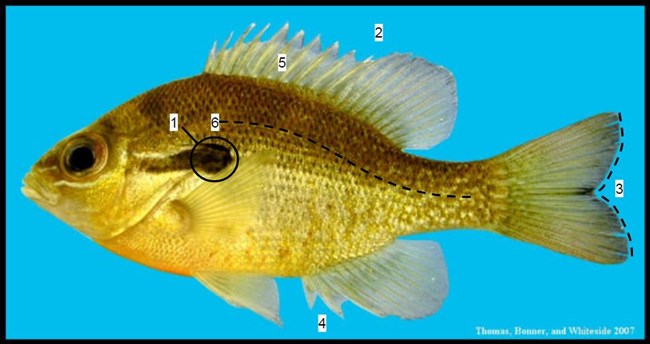
Family: Centrarchidae Genus: Lepomis Sunfish are widespread across the continental United States and Canada. You can find one species or another in just about any river, lake, and pond. Well known for their spiny fins and distinct colors and shape, they are a popular gamefish for anglers of all kinds.

Chad Thomas (Lepomis auratus) The redbreast is a popular sportfish, often found in rivers and streams as opposed to lakes or reservoirs. Originally native to systems across the Atlantic coast, the redbreast has found its way as far west as texas in recent years. It has since been noted as one of many species infringing on the habitat of the Devils River minnow. The redbreast possess a long flexible opercle flap on adults. They have short pectoral fins that do not reach beyond eye when bent forward. Breeding males will have an orange burst on their belly. 
Chad Thomas (Lepomis macrochirus) Pound for pound, the bluegill has proven to put up a greater fight than most other Lepomis and has become a very popular sport fish in response. It reaches larger size than most Lepomis as well. This particular species is commonly used in biology and toxicology research, and is often used as an indicator of the overall health of its watershed The bluegill has dark, slightly flexible opercle flaps. It’s pectoral fins are long and pointed, reaching beyond the eye when bent forward. Most have a dark spot on end of dorsal fin, but it is usually faded in juveniles and large adults. 
Chad Thomas (Lepomis Cyanellus) The hybrid sunfish is a peculiar sunfish with unique colors. Perhaps the most primitive in the Lepomis family, the hybrid sunfish gets its name from its ability to breed with at least 5 other species in the genus. While it is usually too small to be an interest to anglers, they have been noted as a major food source for the largemouth bass. The hybrid has an opercle with a yellow or white margin surrounding a large black dot. They often have a black blotch at the end of both the anal and dorsal fins. The sides of its head are iridescent blue and green. 
Chad Thomas (Lepomis gulosus) Preferring clear and calm waters with an abundance of plant life, the warmouth fits in right at home here in Amistad. This popular sportfish has a distinct and bold look that can make it easy to identify against other Lepomis, though it can hybridize with many of them. Unlike other sunfish, this fish is not known to overpopulate ponds and lakes, and often develops stunted populations. The warmouth has distinct red eyes. Dark brown and yellow lines run from its eyes to the edges of the gill cover. Its body fins have a dark mottling pattern. The lateral line is very visible and very dorsally curved 
Chad Thomas (Lepomis megalotis) The longear sunfish is widespread across much of the central United States and Texas. This fish is a polyphil, meaning it has little preference to where it lays its eggs. Its eggs have adhesive on them allowing them to be laid just about anywhere that has low current. It is primarily an insectivore and piscivore, meaning it eats mostly insects and small fish The longear has a dark opercle flap with a thin white margin. Dorsal regions are often iridescent green or turquoise. Short rounded pectorals do not reach eye when bent forward. Its body is much more rounded in shape than local species in adulthood. 
Chad Thomas (Lepomis microlophus) The redear has a feeding behavior that is unique to Lepomis. They will swim headfirst into whatever substrate is present, raising clouds of sand, mud, and detritus, searching for and crushing bottom dwelling prey such as mayflies, snails, and mollusks. Due to their feeding behavior, among other factors, they are known to decline in population in most lakes and rivers over time, as they lose out in competition to other sunfish. They are also a very popular research fish as they are easier to handle, and are not easily made nervous. The redears opercle margin is dark with red spot on caudal end. It has an Inflexible opercle flap. Juveniles have vertical bars on their sides. |
Last updated: April 21, 2025
